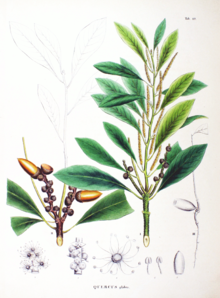Lithocarpus glaber
Appearance
| Lithocarpus glaber | |
|---|---|

| |
| Lithocarpus glaber illustration in Flora Japonica, Sectio Prima (Tafelband) | |
| Scientific classification | |
| Kingdom: | Plantae |
| Clade: | Tracheophytes |
| Clade: | Angiosperms |
| Clade: | Eudicots |
| Clade: | Rosids |
| Order: | Fagales |
| Family: | Fagaceae |
| Genus: | Lithocarpus |
| Species: | L. glaber
|
| Binomial name | |
| Lithocarpus glaber | |
| Synonyms | |
|
Pasania glabra (Thunb.) Oerst. | |
Lithocarpus glaber, the Japanese oak, is a tree species in the genus Lithocarpus found in Japan, China and Taiwan.
Mitami Shrine, a Shinto shrine in Sakai, Osaka Prefecture, Japan, is famous locally for its comparatively large population of Lithocarpus glaber, known as Shiribukagashi (尻深樫 シリブカガシ). In China, it is called ke (柯). In Cantonese, it is called Seklik (石櫟).
Condensed tannins from L. glaber leaves have been analysed through acid-catalyzed degradation in the presence of cysteamine and have a potent free radical scavenging activity.[1]
See also
[edit]- Quercus crispula - Japanese oak - 水楢
References
[edit]External links
[edit]Wikispecies has information related to Lithocarpus glaber.
Wikimedia Commons has media related to Lithocarpus glaber.
- "Lithocarpus glaber". Germplasm Resources Information Network. Agricultural Research Service, United States Department of Agriculture.
